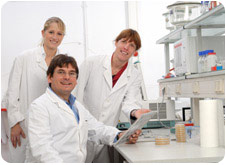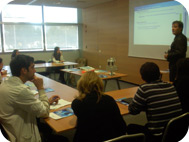LabCluster
|
|
La participation est gratuite sur inscription Il est possible de participer à la totalité de la journée ou seulement à une ou plusieurs conférences. |
|||||
| Cliquez ici pour vous inscrire |
|
||||
Programme :
| |
8h30 | Welcome participants 9h00-9h15 | Introduction par le Club 3D du Centre de Recherche des Cordeliers 9h15-9h45 | CORNING | Organoid culture and high-throughput applications Countless medical breakthroughs over the past century have begun with two-dimensional (2D) cell culture models. However, the limitations of 2D culture are immediately obvious –cells, tissues, and organs exist in three dimensions, not two, and tissues almost always consist of more than one cell type. By providing greater physiologic relevance, 3D cultures narrow the bridge between in vitro and live-animal or human assays. In this scenario, organoids show promise for their physiologic-like complexity and manufacturability, as they capture many of the relevant interactions that cells experience in vivo. These 3D, organ-like collections of cells create innovative approaches to drug development and high-throughput applications. This seminar will cover organoid models and technology, its use for high-throughput applications, and tips for optimal organoid generation and culture. 9h45-10h15 | BIO-TECHNE | Bio-Techne Innovative solutions for organoids research Today, 3D cell culture models constitute a key point in research projects. An organoid is a miniaturized version of an organ produced in vitro that exhibits realistic microanatomy. capable of self-renewal and self-organization and exhibits similar functionality to the original tissu. But each type of organoid has its own specific needs. In this context, Bio-Techne has developed different types of matrices (Cultrex products), media and supplements (proteins and small molecules) to best meet this need. 10h15 -10h45 | Nicolas AZNAR, PhD, CRCN CNRS (CRCL) | Counteracting Organoid Stemness Exhaustion Through Micro-environmental Control: Advancing Toward Standardization and Robust In Vitro Modeling Organoid models have emerged as highly versatile and invaluable tools for investigating intricate cellular dynamics and faithfully replicating tissue complexity in controlled in vitro settings. The influence of culture conditions on organoid behavior, with a specific focus on crucial aspects such as cell viability and stemness maintenance, continues to captivate scientific interest and incite extensive investigation. To address this critical research question, we devised an innovative and purpose-built device (STEADY-STEM Technology) to standardize the process of extracellular matrix loading and cell media diffusion, thereby establishing a more homogenous microenvironment for organoid cultivation. The device's demonstrated cross-species applicability presents a highly promising avenue for standardizing organoid technology, thereby empowering researchers to harness the full potential of organoid models across diverse scientific applications, including regenerative medicine and disease modeling. | Coffee Break 11h00-11h30 | CTI BIOTECH | World’s First Long-Term Colorectal Cancer Model by 3D Bioprinting as a Mechanism for Screening Oncolytic Viruses Long-term modelization of cancer as it changes in the human body is a difficult goal, particularly when designing and testing new therapeutic strategies. This becomes even more difficult with metastasis modeling to show chemotherapeutic molecule delivery directly to tumoral cells. Advanced therapeutics, including oncolytic viruses, antibody-based and cell-based therapies are increasing. The question is, are screening tests also evolving? Next-generation therapeutics need equally advanced screening tests, which whilst difficult to achieve, are the goal of our work here, creating models of micro- and macrotumors using 3D bioprinting. We developed advanced colorectal cancer tumor processing techniques to provide options for cellular expansion, microtumor printing, and long-term models, which allow for the evaluation of the kinetics of penetration testing, therapeutic success, targeted therapies, and personalized medicine. We describe how we tested tumors from a primary colorectal patient and, applying 3D bioprinting, matured long-term models for oncolytic metastatic screening. Three-dimensional microtumors were kept alive for the longest time ever recorded in vitro, allowing longitudinal studies, screening of oncolytic viruses and realistic modelization of colorectal cancer. These 3D bioprinted models were maintained for around 6 months and were able to demonstrate the effective delivery of a product to the tumoral environment and represent a step forward in therapeutic screening. 11h30-12h35 | VIZGEN | Mapping the Future with Spatial Genomics: Applying MERFISH Technology to Map the 3D Organization of the Transcriptome Biological systems are composed of numerous cell types, intricately organized to form functional tissues and organs. While recent advancements in genomics technologies have made it possible to characterize cell types through careful analysis of the transcriptome, they are unable to resolve how gene expression and cell types are spatially arranged, particularly when it comes to the 3D organization of the transcriptome. In this presentation, we introduce the Vizgen’s all-in-one in situ genomics platform MERSCOPE which enables the direct profiling of the spatial organization of intact tissue with genomic-scale throughput. The instrument, the MERFISH chemistry, use cases, and data analysis solutions will be presented. Stands en libre accès toute la matinée et pendant le cocktail : BIO-TECHNE, CORNING, CTI BIOTECH, PROMEGA, THERMOFISHER, VIZGEN ••••••••••••••••••••••••••••••••••••••••••••••••••••••• | Cocktail Lunch ••••••••••••••••••••••••••••••••••••••••••••••••••••••• |
||
|
Stands de démonstration et d'information en libre accès. Venez nous rencontrer. |
|||

| Le nombre de places étant limité, il est fortement conseillé de s'inscrire à l'avance en cliquant ici |
|
|||
| Pour toute question ou demande d'information, cliquez ici | |
![]()



